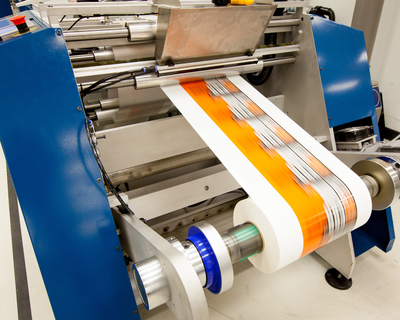As one of the key measures for inkjet print quality, it is important to understand how print resolution helps define the quality of the output in terms of dpi, effective dpi and greyscale. By Philip Easton, director, digital printing solutions at Domino Printing Sciences
Over the past few years, digital inkjet technology has continued to push the boundaries of innovation with a steady stream of technological advances that has given inkjet the same levels of performance, cost effectiveness and efficiency of other digital and more traditional methods of print. As a result, high speed piezo drop on demand inkjet has become the most significant front runner in the digital print sector in recent years, with several companies launching digital inkjet presses offering highly efficient, high quality output.
Fundamentally, the basis of the print quality and productivity achieved from these new inkjet printers is largely determined by the type of printhead that is integrated within the press and with that has emerged a new language to help define the quality of output. Typically, the most common methods of defining output quality relies on dots per inch (dpi), effective dpi and greyscale.
Dots per inch
Print resolution, although not the only measure, remains one of the key methods of measuring print quality. For those more familiar with flexographic technology, this is commonly quoted in the form of lines per inch. In contrast, with inkjet technology, whether you are measuring print resolution for desktop devices or full scale commercial UV-curable presses, it tends to be quoted in dots per inch or dpi. Dpi defines the density of dots that can be printed in one inch to form printed text or graphics. The more dots printed per inch, the higher the print resolution of the image.
Greyscale
Closely related to dpi in terms of impacting and measuring print quality is the range of droplet size that is used in the printing process. This is often referred to as greyscale capability.
Today, all the latest inkjet printheads support greyscales. However, generally lower resolution (lower dpi) printheads will be printing more greyscales, with on average larger drops being used in order to create the required ink coverage.
 Philip Easton, director
Philip Easton, director
Vertical v horizontal
Print resolution can also be different in the vertical and horizontal axes of the image. For an inkjet press, the dpi running perpendicular to the travel direction of the printed substrate is fixed. In this case, the dpi is defined by the number of nozzles per inch within the printheads printing the image. In contrast, when reviewing the dpi of the substrate travel direction, this is determined by a number of different factors including the jetting frequency of the printhead, the number of greyscales being usedas well as operational speed.
In instances where there are fewer greyscales being printed, while higher running speeds are possible, print density and the consequent availability of colour range may be compromised. In addition, if you halve the print resolution in the material travel direction, it can be possible to double the speed recognising the printhead has a defined jetting frequency.
For this reason in some cases, dpi is defined in two axes for example as 600 x 300 dpi. This means it prints at 600 dpi in one axis and 300 dpi in the other axis.
Printhead technology
There are currently two dominant inkjet printhead technologies being used within digital label presses, the Xaar 1001 and the Kyocera KJ4A.
The Xaar 1001 printhead is used by most inkjet label press manufacturers. This printhead has a native print resolution of 360 dpi, typically operating at 25 m/min with 360 x 360 dpi and eight greyscales.
Xaar has combined the greyscale capability with print resolution and quote ‘effective’ or ‘apparent’ print resolution. This is broadly calculated as the square root of the number of greyscales multiplied by the native dpi. Therefore, although the printhead doesn’t actually produce 1,000 drops per inch, Xaar claims an ‘effective’ resolution of over 1,000 dpi. The printhead has eight greyscales (a blank droplet where no ink is ejected is counted as one greyscale) with drop sizes between 6 pl and 42 pl (pico litre).
The Kyocera KJ4A printhead has a native resolution of 600 dpi, operating at 50 m/min with 600×600 dpi and four greyscales (five including the ‘no drop’). This would imply an ‘effective’ resolution of 1,340 dpi. Within one square inch, therefore, it can deliver up to 360,000 individual drops compared to 129,600 typically larger drops from the Xaar 1001 printhead.
The Kyocera KJ4A printhead has four greyscales with drop sizes of between 6 pl and 14 pl. With more droplets available for printing, the average drop size is much smaller. As a result, it is reasonably claimed that fewer greyscales are really required given the higher native resolution available.
There are of course many other factors that will determine the ultimate quality of the printed output, including registration control, print density and ink flow for example. But ultimately, it is the underlying technology and capabilities of the printhead that will determine print resolution and the level of detail that can be achieved in the printed image.
Generally speaking, the higher the native resolution of a printhead, the greater the detail that can be reflected in the image, although it is possible for lower native resolution print heads to partly compensate for this through offering more greyscales.
When reviewing print quality and considering what print resolution is best, it is highly recommended to print a range samples of images, text and graphics onto a number of different substrates to provide a full picture of what can be achieved and whether it matches the print quality required.






